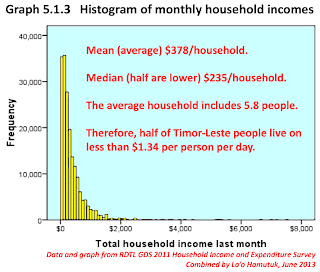Because the GDS website has some technical problems, La’o Hamutuk posted these reports on our website (click on each heading to download the report). At present they are mainly in English; we will add Tetum versions as they become available.
2011 Household Income and Expenditure Survey
Between January 2011 to January 2012, GDS interviewed 4,800 households across Timor-Leste (about 2.6% of the total) about their cash and in-kind income and expenditures, as well as other topics. The results, the first for this country, are an invaluable window into people’s lives and Timor-Leste’s economy. The Government delayed publication of the HIES report for a year, removing the calculation of the Poverty Line (to avoid comparison with 2007, when 49.9% of Timor-Leste’s people lived on less than 88 cents/day), but a great deal of useful data remains. Here are a few tidbits:- The mean (average) monthly income per person is $93 in urban households and $50 in rural ones.
- Less than one-fourth of this is from wages; in rural areas more than half is from agriculture.
- The median per capita monthly income (including in-kind income and imputed rent) is $40 ($24 in Oecusse), meaning that half of Timor-Leste’s people get by on less than $1.33 per day. [With 34% overall inflation from 2007 to 2011, the poverty line is significantly higher than 2007’s 88¢/day.]
- The richest 10% receives nearly 14 times as much income as the poorest 10%.
- Urban people spend more than twice as much as rural people, even when the value of food obtained by labor or barter is included. More than half of rural people spend less than a dollar a day.
- Rural people spend 78% of their household budget on food, of which less than 40% is bartered or produced by themselves.
- 57% of all wage income is paid by the Government.
- Urban households consume four times as much fish and dairy as rural ones, and twice as much meat and vegetables, but rural people eat more rice, tubers and roots.
- Urban households spend seven times as much on beer as rural ones, although rural people spend more on locally-produced alcohol.
- The HIES report also discusses education, age, health, possessions, hunger, crime, smoking, transportation, social benefits, ceremonies and many other issues.


2000-2011 National Accounts
This report, the second of its kind, estimates the size of each component of Timor-Leste’s economy using three methods: production, expenditure and income. In addition to calculating the Gross Domestic Product (GDP) and watching it grow over time, the NA report shows money coming into and out of the country, as well as the contribution and trends of various sectors. Among its interesting revelations:- 80.5% of our GDP in 2011 came from oil and gas extraction. The non-oil GDP was $1.1 billion in current prices, out of a total of $5.8 billion.
- Of the non-oil GDP, 21% was from construction, 20% from public administration, 19% from trade, 17% from agriculture, 8% from real estate and 15% from all other sectors.
- Total non-oil GDP increased 12% from 2010 to 2011. In that time, agriculture shrank by 20% while (mostly state-financed) construction grew by 40% and public administration grew by 25%.
- During 2011, Timor-Leste exported $34 million in goods (excluding oil) and $77m in services, for a total export income of $111 million.
- During 2011, we imported $325 million in goods and $1,033m in services (excluding the oil sector), for a balance of payments deficit of $1.25 billion, 16% higher than in 2010.
2011 Business Activities Survey
GDS interviewed a sample of 1,073 of the 5,273 business registered in Timor-Leste, excluding the petroleum sector but including all large companies operating here, and compared the responses with their 2010 study. Among the interesting results:- 58,200 people were employed by the private sector at the end of 2011, 75% whom were male, out of a total working age population of more than 600,000.
- Between 2010 and 2011, the number of women employed increased by only 7% while the number of men increased 25%. (This is partly from the large increase in the construction sector, but the gender bias is in most sectors.)
- Although business profits increased by 39% over 2010 (to $355 million), capital expenditure (investing to make the business grow) dropped by 13%. Dili-based businesses re-invested only 9% of their profits in 2011 (down from 20% in 2010), while companies in the districts re-invested 55% (up from 26% in 2010). Although this is partly because foreign companies are primarily registered in Dili, investment was less than 20% of profit in every sector of the economy.
Series 2 Consumer Price Index
Although GDS has sampled prices and published the Consumer Price Index (CPI) for many years, in late 2012 they used the HIES to redesign their methodology, changing the way data is collected, the weights given to different types of products, and publishing separate CPIs for Dili and the rest of Timor-Leste. They recently released reports for the first four months of 2013, the first using the new methodology. These reports and GDS’s explanatory papers are on La’o Hamutuk’s website; future reports will be accessible from the GDS website.The new reports from the General Directorate for Statistics contain a wealth of data (as does their end-of-2012 Quarterly Statistical Indicators brochure), but there are other sources of useful information. La’o Hamutuk also recently published Mari Alkatiri’s presentation on the proposed Oecusse Special Economic Zone, the Finance Ministry’s Yellow Road Workshop documents describing Timor-Leste’s fiscal situation, and some of the tender and EIA documents for the Suai Airport, Suai Supply Base, and the first phase of the Suai-Beaçu highway. We welcome additional information from all sources.










No comments:
Post a Comment